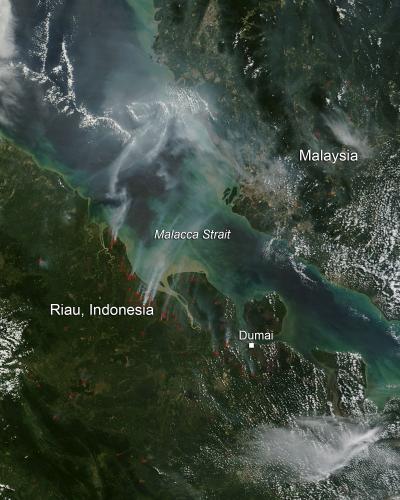Fires in Indonesia, July 2014

Terra and Aqua satellites detected 154 hotspots in areas across Riau province on Sunday, July 20, indicating forest and land fires had increased again following a decline in rainfall. The number of detected hotspots in Sunday's report was far higher than what had been reported one day prior, which had reached only 75 spots. Credit: NASA image courtesy Jeff Schmaltz, MODIS Rapid Response Team. Caption: NASA/Goddard, Lynn Jenner
The number of detected hotspots in Sunday's report was far higher than what had been reported one day prior, which had reached only 75 spots.
The hotspots were scattered in six regencies and municipalities, most of which were in northern Riau coastal areas. Smoke and the related haze it creates could potentially spread via winds to Malaysia and Singapore as it seems to be doing in this image.
The smoke released by any type of fire is a mixture of particles and chemicals produced by incomplete burning of carbon-containing materials.
All smoke contains carbon monoxide, carbon dioxide and particulate matter (PM or soot). The type and amount of particles and chemicals in smoke varies depending on what is burning, how much oxygen is available, and the burn temperature.
Smoke degrades air quality and precautions should be taken when around it.
This natural-color satellite image was collected by the Moderate Resolution Imaging Spectroradiometer (MODIS) aboard the Terra satellite on July 20, 2014.
Actively burning areas, detected by MODIS's thermal bands, are outlined in red.
Media Contact
More Information:
http://www.nasa.govAll latest news from the category: Earth Sciences
Earth Sciences (also referred to as Geosciences), which deals with basic issues surrounding our planet, plays a vital role in the area of energy and raw materials supply.
Earth Sciences comprises subjects such as geology, geography, geological informatics, paleontology, mineralogy, petrography, crystallography, geophysics, geodesy, glaciology, cartography, photogrammetry, meteorology and seismology, early-warning systems, earthquake research and polar research.
Newest articles

Superradiant atoms could push the boundaries of how precisely time can be measured
Superradiant atoms can help us measure time more precisely than ever. In a new study, researchers from the University of Copenhagen present a new method for measuring the time interval,…

Ion thermoelectric conversion devices for near room temperature
The electrode sheet of the thermoelectric device consists of ionic hydrogel, which is sandwiched between the electrodes to form, and the Prussian blue on the electrode undergoes a redox reaction…

Zap Energy achieves 37-million-degree temperatures in a compact device
New publication reports record electron temperatures for a small-scale, sheared-flow-stabilized Z-pinch fusion device. In the nine decades since humans first produced fusion reactions, only a few fusion technologies have demonstrated…





















